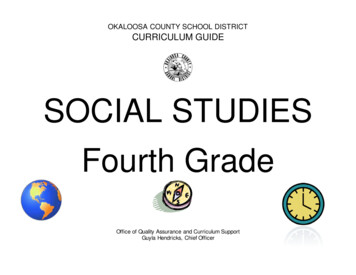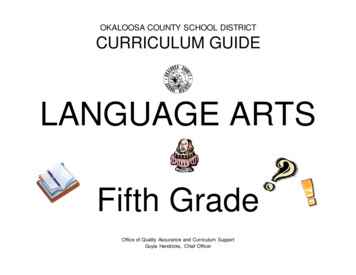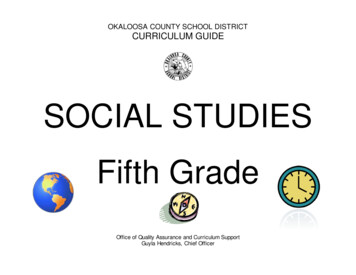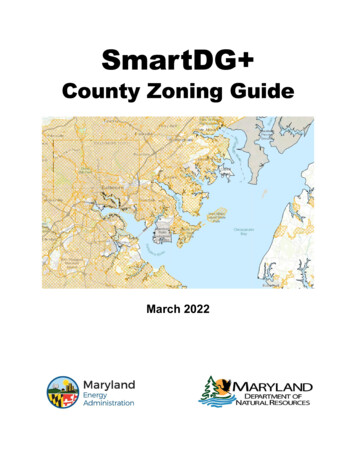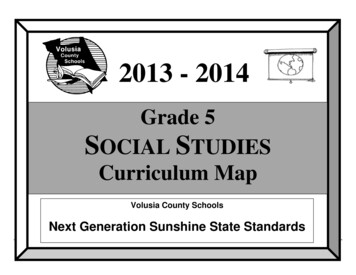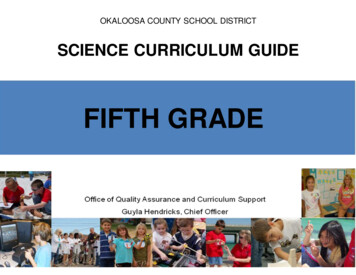
Transcription
OKALOOSA COUNTY SCHOOL DISTRICTSCIENCE CURRICULUM GUIDEFIFTH GRADE
Okaloosa County School DistrictCurriculum Guide for ScienceCONTENTSMission Statement. 3Suggestions for Implementing Curriculum Guides . 3Florida Department of Education Office of Math and Science Essential Website . 4OCSD Curriculum and Pacing Guide Overview . 4Cognitive Complexity/Depth of Knowledge Rating for Science . 6Assessment Options . 75th Grade Science Standards . 8Related Common Core Standards/Benchmarks . 9Quarterly Benchmarks . 10Reading Standards for Informational Text K–5 . 13Writing Standards for Grade 5 . 14Grade-level Curriculum Guide . 15Quarter 1 . 15Quarter 2 . 23Quarter 3 . 27Quarter 4 . 32Textbook Correlation to Florida Science Standards. 33Science Resources Guide . 38Science Literature by Grade Level with Benchmarks . 39Research . 535 Questions to Deeper Understanding . 54Standards-Based Instruction. 55Backward by Design . 55REV 062012Fifth Grade SciencePage 2
Okaloosa County School DistrictCurriculum Guide for ScienceMission StatementDevelop the highest quality science instruction and maximize student achievement by aligning grade-level benchmarks to appropriate instructionalpractices, materials, resources, and pacing.Suggestions for Implementing Curriculum GuidesThe role of the teacher is to: Teach students the Next Generation Standards as dictated by state law for their grade level.Provide learning-rich classroom activities that teach the benchmarks in depth.Enhance the curriculum by using resources and instructional technology.Differentiate instruction by varying methods of instruction and frequently offering relevant lab activities.Regularly administer assessment to include higher-level questions and performance task assessment.In addition, teachers should: Collaborate with other grade-level teachers to maximize school resources and teacher expertise.Consult with other grade levels to define absolute skill goals for each grade level.Document questions and suggestions for improvement of the Curriculum Guide.Integrate science into math and reading curriculum.Consider applying for a grant to support project-based learning for their school.Visit the Okaloosa Science Central Website at: http://www.okaloosa.k12.fl.us/scienceDays allotted to each benchmark are approximate and have been suggested based on the level of the complexity ofthe benchmark. To insure benchmarks are taught to mastery and completed by the conclusion of the school year, itis recommended that teaches not veer significantly from the suggested pacing.REV 062012Fifth Grade SciencePage 3
Okaloosa County School DistrictCurriculum Guide for ScienceFlorida Department of Education Office of Math and Science Essential WebsiteNext Generation Sunshine State /index.aspxOCSD Curriculum and Pacing Guide OverviewThis document provides a science curriculum and pacing guide. It is designed to help teachers to efficiently pace the delivery of quality instruction for each nineweek period.Purpose: This guide was created by a team of grade-level teachers to correlate to the Next Generation Standards with the goal of providing teachers ready accessto resources for teaching those new standards and a pace for accomplishing benchmark mastery.Description: The OCSD Science Curriculum Guide specifies the science content to be covered within each nine-week instructional period. Their guide identifiesNext Generation Standards (NGS) Benchmarks. Furthermore, it allows teachers to input information specific to their students or school needs. Top Block – Big Idea and Essential QuestionsIdentifies the Big Idea and the components of the Big Idea. Lists the Essential Questions addressed in the sections Benchmarks. Column One – Benchmark/Text AlignmentLists the specific Benchmark by number and states the Benchmark. Cites the Houghton Mifflin Harcourt Florida Science Fusion textbook pages that correlateto the Benchmark. Column Two – FCAT InfoServes as a placeholder for future FCAT information; to include content limits, complexity, assessment status, and crosswalk correlation. Column Three – Additional Resources/ActivitiesSuggests instructional activities, including media (DVD/Video/CD), websites, and student involvement tasks.REV 062012Fifth Grade SciencePage 4
Okaloosa County School DistrictCurriculum Guide for Science Column Four – Literacy Connection/Vocabulary/ReadingLists vocabulary words, specific literary resources, and other books or stories connected to the Benchmark goals. Column Five – Open: Specific to Teacher/Grade/Subject/SchoolServes as a placeholder for teachers to add information that is specific to their school’s or student’s needs.Of note: Benchmarks drive instructional decisions; the text is a resource Results of assessment are used to adjust and revise instruction Hands-on science labs are an essential component of the science curriculum The inquiry process must be embedded within every big/supporting ideaNOTE:Addendums to this curriculum guide, as well as additional information/forms (i.e. elementary lab templates) will be posted es/tabid/378/Default.aspx.REV 062012Fifth Grade SciencePage 5
Okaloosa County School DistrictCurriculum Guide for ScienceCognitive Complexity/Depth of Knowledge Rating for ScienceFlorida’s revised science standards emphasize teaching and learning the most important K-12 science concepts in depth at each grade level. Afteradoption of the new science standards, the Florida Center for Research in Science, Technology, Engineering and Mathematics (FCR-STEM) atFlorida State University convened a group of Florida science teachers, district math supervisors, and science education faculty, and scientists torate the cognitive demand of each benchmark. Meeting in teams for each body of knowledge, they reviewed and discussed each benchmark, thenreached consensus on level of cognitive complexity using a classification system adapted from the “depth of knowledge” system developed by Dr.Norman Webb at the University of Wisconsin.Cognitive complexity refers to the cognitive demand of tasks associated with the benchmark. The depth of knowledge levels (W ebb, 1999) reflectthe relative complexity of thinking that a given benchmark demands of students — what it requires the student to recall, understand, analyze, anddo. Florida’s depth of knowledge rating system focuses on expectations of students at three levels:Low ComplexityScience low complexity items rely heavily on the recall and recognition of previously learned concepts and principles. Items typically specify whatthe student is to do, which is often to carry out a procedure that can be preformed mechanically. It is not left to the student to come up with anoriginal method or solution. Skills required to respond correctly to a low complexity item might include the following. Identify a common example or recognize a concept Retrieve information from a chart, table, diagram, or graph Recognize a standard scientific representation of a simple phenomenon Calculate or complete a familiar single-step procedure or equation using a reference sheetModerate ComplexityItems in the moderate complexity category involve more flexible thinking and choice among alternatives than low complexity items. They require aresponse that goes beyond the habitual, is not specified, and ordinarily has more than a single step or thought process. The student is expected todecide what to do – using informal methods of reasoning and problem solving strategies – and to bring together skill and knowledge from variousdomains. Skills required to respond correctly to moderate complexity items might include the following. Apply or infer relationships among facts, terms, properties, or variables Describe examples and non examples of scientific processes or concepts Predict or determine the logical next step or outcome Compare or contrast structures or functions of different organisms or systems Choose the appropriate formula or equation to solve a problem and then solve itREV 062012Fifth Grade SciencePage 6
Okaloosa County School DistrictCurriculum Guide for Science Apply and use concepts from a standard scientific model or theoryHigh ComplexityHigh complexity items make heavy demands on student thinking. Students must engage in more abstract reasoning, planning, analysis, judgment,and creative thought. The items require that the student think in an abstract and sophisticated way often involving multiple steps. Skills required torespond to high complexity items might include the following. Construct models for research Generalize or draw conclusions Design an experiment, given data and condition Explain or solve a problem in more than one way Provide a justification for steps in a solution or process Analyze an experiment to identify a flaw and propose a method for correcting it Interpret, explain, or solve a problem involving complex spatial relationships Predict a long term effect, outcome, or result of a change within a systemWebb, N.L., 1999, Alignment Between Standards and Assessment, University of Wisconsin Center for Educational Research.Source: Cognitive Complexity Classification of FCAT SSS Test Items, July, 2006 and revised January, 2008; Florida Department of Education.Assessment OptionsPractice Grades Leveled reader practice sheetInquiry flip chart activityStudent Unit Benchmark ReviewREV 062012Progress Monitoring Brain CheckLesson QuizzesStudents Lab Performance tasksFifth Grade ScienceSummative Unit Benchmark testTeacher created tests, such as ExamviewPage 7
Okaloosa County School DistrictCurriculum Guide for Science5th Grade Science StandardsBig Idea 1 – The Practice of ScienceBig Idea 2 – The Characteristics of Scientific KnowledgeBig Idea 5 – Earth in Space and TimeBig Idea 7 – Earth Systems and PatternsBig Idea 8 – Properties of MatterBig Idea 9 – Changes in MatterBig Idea 10 – Forms of EnergyBig Idea 11 – Energy Transfer and TransformationsBig Idea 13 – Forces and Changes in MotionBig Idea 14 – Organization and Development of Living OrganismsBig Idea 15 – Diversity and Evolution of Living OrganismsBig Idea 17 – InterdependenceThe numbering for the big ideas is consistent throughout the document. Not all big ideas are addressed at each grade level, s o thenumbering scheme is not consecutive for each grade level.Benchmark Coding SchemeREV 062012SC.5.N.1.1SubjectGrade LevelBody of KnowledgeBig IdeaBenchmarkFifth Grade SciencePage 8
Okaloosa County School DistrictCurriculum Guide for ScienceRELATED COMMON CORE STANDARDS/BENCHM ARKSLACC.5.RI.1 Key Ideas and DetailsLACC.5.RI.1.3 Explain the relationships or interactions between two or more individuals, events, ideas, or concepts in a historical, scientific, ortechnical text based on specific information in the text.LACC.5.RI.2 Craft and StructureLACC.5.RI.2.4 Determine the meaning of general academic and domain-specific words and phrases in a text relevant to a grade 5 topic or subjectarea.LACC.5.RI.4 Range of Reading and Complexity of TextLACC.5.RI.4.10 By the end of the year, read and comprehend informational texts, including history/social studies, science, and technical texts, atthe high end of the grades 4–5 text complexity band independently and proficiently.LACC.5.W.3 Research to Build and Present KnowledgeLACC.5.W.3.8 Recall relevant information from experiences or gather relevant information from print and digital sources; summarize or paraphraseinformation in notes and finished work, and provide a list of sources. LACC.5.W.3.9 Draw evidence from literary or informational texts to supportanalysis, reflection, and research.LACC.5.SL.1 Comprehension and CollaborationLACC.5.SL.1.1 Engage effectively in a range of collaborative discussions (one-on-one, in groups, and teacher-led) with diverse partners on grade 5topics and texts, building on others’ ideas and expressing their own clearly.MACC.5.MD Measurement and DataMACC.5.MD.2 Represent and interpret data.MACC.5.MD.2.2 Make a line plot to display a data set of measurements in fractions of a unit (1/2, 1/4, 1/8). Use operations on fractions for thisgrade to solve problems involving information presented in line plots. For example, given different measurements of liquid in identical beakers, findthe amount of liquid each beaker would contain if the total amount in all the beakers were redistributed equally.MACC.5.G GeometryMACC.5.G.1 Graph points on the coordinate plane to solve real-world and mathematical problems.MACC.5.G.1.1 Use a pair of perpendicular number lines, called axes, to define a coordinate system, with the intersection of the lines (the origin)arranged to coincide with the 0 on each line and a given point in the plane located by using an ordered pair of numbers, called its coordinates.Understand that the first number indicates how far to travel from the origin in the direction of one axis, and the second num ber indicates how far totravel in the direction of the second axis, with the convention that the names of the two axes and the coordinates correspond (e.g., x-axis and xcoordinate, y-axis and y-coordinate).REV 062012Fifth Grade SciencePage 9
Okaloosa County School DistrictCurriculum Guide for ScienceQuarterly BenchmarksQuarter 1Quarter 2 SC.5.N.1.1HighMA.5.S.7.1MA.5.S.7.2 SC.5.N.1.2Moderate Define a problem, use appropriate reference materials to supportscientific understanding, plan and carry out scientificinvestigations of various types such as: systematic observations,experiments requiring the identification of variables, collectingand organizing data, interpreting data in charts, tables, andgraphics, analyze information, make predictions, and defendconclusions. SC.5.N.1.3Moderate Explain the difference between an experiment and other types ofscientific investigation. SC.5.N.1.4Moderate Recognize and explain the need for repeated experimental trials. SC.5.N.1.5Moderate SC.5.N.1.6Moderate SC.5.N.2.1Moderate SC.5.N.2.2Moderate1st 10 dayfocus,continuousthroughout theyear Identify a control group and explain its importance in anexperiment Recognize and explain that authentic scientific investigationfrequently does not parallel the steps of "the scientific method." Recognize and explain the difference between personalopinion/interpretation and verified observation.Compare and contrast the basic properties of solids, liquids, andgases, such as mass, volume, color, texture, and temperature.SC.5.P.8.2High5 daysInvestigate and identify materials that will dissolve in water andthose that will not and identify the conditions that will speed up orslow down the dissolving process.SC.5.P.8.3Moderate4 daysDemonstrate and explain that mixtures of solids can be separatedbased on observable properties of their parts such as particle size,shape, color, and magnetic attraction.SC.5.P.8.4Low4 daysExplore the scientific theory of atoms (also called atomic theory)by recognizing that all matter is composed of parts that are toosmall to be seen without magnification.SC.5.P.9.1High4 daysInvestigate and describe that many physical and chemicalchanges are affected by temperature. Recognize and explain that science is grounded in empiricalobservations that are testable; explanation must always belinked with evidence.SC.5.P.10.1Moderate2 daysInvestigate and describe some basic forms of energy, includinglight, heat, sound, electrical, chemical, and mechanical. Recognize and explain that when scientific investigations arecarried out, the evidence produced by those investigationsshould be replicable by others.SC.5.P.10.2High4 daysInvestigate and explain that energy has the ability to cause motionor create change.SC.5.P.10.3High4 daysInvestigate and explain that an electrically-charged object canattract an uncharged object and can either attract or repel anothercharged object without any contact between the objects.SC.5.P.10.4High4 daysInvestigate and explain that electrical energy can be transformedinto heat, light, and sound energy, as well as the energy of motion.Quarter 1 continued next pageREV 062012SC.5.P.8.1Moderate4 dayQuarter 2 continued next pageFifth Grade SciencePage 10
Okaloosa County School DistrictCurriculum Guide for ScienceQuarter 1 continuedQuarter 2 continuedSC.5.E.5.1Low3 daysRecognize that a galaxy consists of gas, dust, and many stars,including any objects orbiting the stars. Identify our home galaxy asthe Milky WaySC.5.P.11.1Moderate2 daysSC.5.E.5.2High4 daysRecognize the major common characteristics of all planets andcompare/contrast the properties of inner and outer planets.SC.5.P.11.2Moderate3 daysSC.5.E.5.3Moderate4 daysDistinguish among the following objects of the Solar System -- Sun,planets, moons, asteroids, comets -- and identify Earth's position init.SC.5.E.7.1High5 daysCreate a model to explain the parts of the water cycle. Water can bea gas, a liquid, or a solid and can go back and forth from one state toanother.SC.5.E.7.2Moderate1 dayRecognize that the ocean is an integral part of the water cycle and isconnected to all of Earth's water reservoirs via evaporation andprecipitation processes.SC.5.E.7.3Moderate2 daysRecognize how air temperature, barometric pressure, humidity, windspeed and direction, and precipitation determine the weather in aparticular place and time.SC.5.E.7.4High3 daysDistinguish among the various forms of precipitation (rain, snow,sleet, and hail), making connections to the weather in a particularplace and time.SC.5.E.7.5Moderate1 daysRecognize that some of the weather-related differences, such astemperature and humidity, are found among different environments,such as swamps, deserts, and mountains.SC.5.E.7.6High5 daysDescribe characteristics (temperature and precipitation) of differentclimate zones as they relate to latitude, elevation, and proximity tobodies of water.SC.5.E.7.7Moderate2 dayDesign a family preparedness plan for natural disasters and identifythe reasons for having such a plan.REV 062012Fifth Grade ScienceInvestigate and illustrate the fact that the flow of electricity requiresa closed circuit (a complete loop).Identify and classify materials that conduct electricity and materialsthat do not.Page 11
Okaloosa County School DistrictCurriculum Guide for ScienceQuarter 3Quarter 4SC.5.P.13.1Low2 daysIdentify familiar forces that cause objects to move, such as pushesor pulls, including gravity acting on falling objects.Science Fair (priority)SC.5.P.13.2Moderate5 daysInvestigate and describe that the greater the force applied to it, thegreater the change in motion of a given object.Earth/Arbor Day CelebrationsSC.5.P.13.3Moderate5 daysInvestigate and describe that the more mass an object has, the lesseffect a given force will have on the object's motion.RemediationSC.5.L.15.1Moderate4 daysInvestigate and explain that when a force is applied to an object butit does not move, it is because another opposing force is beingapplied by something in the environment so that the forces arebalanced.Identify the organs in the human body and describe their functions,including the skin, brain, heart, lungs, stomach, liver, intestines,pancreas, muscles and skeleton, reproductive organs, kidneys,bladder, and sensory organs.Compare and contrast the function of organs and other physicalstructures of plants and animals, including humans, for example:some animals have skeletons for support -- some with internalskeletons others with exoskeletons -- while some plants have stemsfor support.Describe how, when the environment changes, differences betweenindividuals allow some plants and animals to survive and reproducewhile others die or move to new locations.SC.5.L.17.1Moderate4 daysCompare and contrast adaptations displayed by animals and plantsthat enable them to survive in different environments such as lifecycles variations, animal behaviors and physical characteristics.SC.5.P.13.4High5 daysSC.5.L.14.1Moderate10 daysSC.5.L.14.2Moderate5 daysREV 062012Fifth Grade ScienceEnrichmentMarsville (optional)6th Grade ExpectationsPage 12
Okaloosa County School DistrictCurriculum Guide for ScienceReading Standards for Informational Text 5Grade 5 Students1. Quote accurately from a text when explaining what the text says explicitly and when drawing inferences from thetext.Key Ideas and Details2. Determine two or more main ideas of a text and explain how they are supported by key details; summarize thetext.3. Explain the relationships or interactions between two or more individuals, events, ideas, or concepts in a historical,scientific, or technical text based on specific information in the text.4. Determine the meaning of general academic and domain-specific words and phrases in a text relevant to a grade5 topic or subject area.Craft and Structure5. Compare and contrast the overall structure (e.g., chronology, comparison, cause/effect, problem/solution) ofevents, ideas, concepts, or information in two or more texts.6. Analyze multiple accounts of the same event or topic, noting important similarities and differences in the point ofview they represent.7. Draw on information from multiple print or digital sources, demonstrating the ability to locate an answer to aquestion quickly or to solve a problem efficiently.Integration of Knowledge andIdeas8. Explain how an author uses reasons and evidence to support particular points in a text, identifying which reasonsand evidence support which point(s).9. Integrate information from several texts on the same topic in order to write or speak about the subjectknowledgeably.Range of Reading and Levelof Text ComplexityREV 06201210. By the end of the year, read and comprehend informational texts, including history/social studies, science, andtechnical texts, at the high end of the grades 4-5 text complexity band independently and proficiently.Fifth Grade SciencePage 13
Okaloosa County School DistrictCurriculum Guide for ScienceWriting Standards for Grade 5Grade 5 Students1. Write opinion pieces on topics or texts, supporting a point of view with reasons and information.Text Types and Purposes2. Write informative/explanatory texts to examine a topic and convey ideas and information clearly.3. Write narratives to develop real or imagined experiences or events using effective technique, descriptive details,and clear event sequences.4. Produce clear and coherent writing in which the development and organization a re appropriate to task, purpose,and audience. (Grade-specific expectations for writing types are defined in standards 1-3 above.)Production and Distribution ofWriting5. With guidance and support from peers and adults, develop and strengthen writing as needed by planning, revising,editing, rewriting, or trying a new approach. (Editing for conventions should demonstrate command of Languagestandards 1-3 up to and including grade 5 on pages 28 and 29.)6. With some guidance and support from adults, use technology, including the Internet, t o produce and publishwriting as well as to interact and collaborate with others; demonstrate sufficient command of keyboarding skills totype a minimum of two pages in a single sitting.7. Conduct short research projects that use several sources to build knowledge through investigation of differentaspects of a topic.Research to Build and PresentKnowledge8. Recall relevant information form experiences of gather relevant information from print and digital sources;summarize or paraphrase information in notes and finished work, and provide a list of sources.9. Draw evidence from literary or informational texts to support analysis, reflection, and research .Range of WritingREV 06201210. Write routinely over extended time frames (time for research, reflection, and revision) and shorter time frames (asingle sitting or a day or two) for a range of discipline-specific tasks, purposes, and audiences.Fifth Grade SciencePage 14
Okaloosa County School DistrictCurriculum Guide for ScienceGrade-level Curriculum GuideQuarter 1Big Idea 1: The Practice of ScienceA. Scientific inquiry is a multifaceted activity; The processes of science include the formulation of scientifically investigable questions, construction ofinvestigations into those questions, the collection of appropriate data, the evaluation of the meaning of those dat a, and the communication of thisevaluation.B. The processes of science frequently do not correspond to the traditional portrayal of "the scientific method."C. Scientific argumentation is a necessary part of scientific inquiry and plays an important role in the generation and validation of scientific knowledge.D. Scientific knowledge is based on observation and inference; it is important to recognize that these are very different things . Not only does sciencerequire creativity in its methods and processes, but also in its questions and explanations.Essential Questions: What is the purpose of scientific method? What are controlled variables? Why are repeated trials necessary? What is the difference between opinion and factual observations?Benchm arkText Alignm entSC.5.N.1.1Define a problem, useappropriate referencematerials to supportscientific understanding,plan and carry outscientific investigations ofvarious types such as:systematic observations,experiments requiring theidentification of variables,collecting and organizingdata, interpreting data incharts, tables, andgraphics, analyzeinformation, makepredictions, and defendconclusions.Text:Unit 1, Lessons 3, 5REV 062012FCAT Info: Contentlim its, Item specs,other assessm entsReference page 9MACC.5.MDLACC.5.W.3Additional Resources/Activitieswww.floridastandards.org- Reference year long forall standards correlation and resources.Unitedstreaming: How Scientists Work: what is the Scientific Method(21:00) Myth Buster: The 3M Young Scientist ChallengeBrainPOPScientific Method, Science ProjectsPicture-Perfect ScienceBrainstorms: from Idea to Inventionwww.sciencespot.netGeneral Science – Scientific Method and SafetyRulesThe Bikini Bottom Gang – Controls and VariablesJunk Box Wars – Scientific Method Tasks andprocess skills.Fifth Grade ScienceLit. ConnectionVocabularyReadingOpen: Specific toteacher, grade,subject, schoolYear Long Resources:Scholastic Resources:National Geographic ExplorerSuper ScienceBooks:Evan Moor Series:Read and UnderstandScienceAIMS Series:Life SciencePhysical ScienceEarth ScienceScienceSaurusImaginative Inventions byCharise HarperPage 15
Okaloosa County School DistrictCurriculum Guide for ScienceConsumers Challenge – Students work in teams tochallenge the claims of products available toconsumers.Science Works for Kids:WeatherThe Human BodySimple ChemistryEnergyPlanet EarthLiving ThingsDifferentiating Instruction With Menus – ScienceSC.5.N.1.2Explain the differencebetween an experimentand other types ofscientific investigation.Moderate complexitySciencebuddies.orgScience Fair resources, classroom activities,“Variables and Hypothesis worksheet”, “Variables inYour Science Fair Project” Worksheet.Girls Think of EverythingStories of Ingenious Inventionsby Women by CatherineThimmeshScience Verse by Jon ScieszkaMacmillan basal “What Does ItTak e to be a Scientist?” pages42-45Macmillan basal “Write aScientific Observation” pages446-447Macmillan basal
Florida's revised science standards emphasize teaching and learning the most important K-12 science concepts in depth at each grade level. After adoption of the new science standards, the Florida Center for Research in Science, Technology, Engineering and Mathematics (FCR-STEM) at

